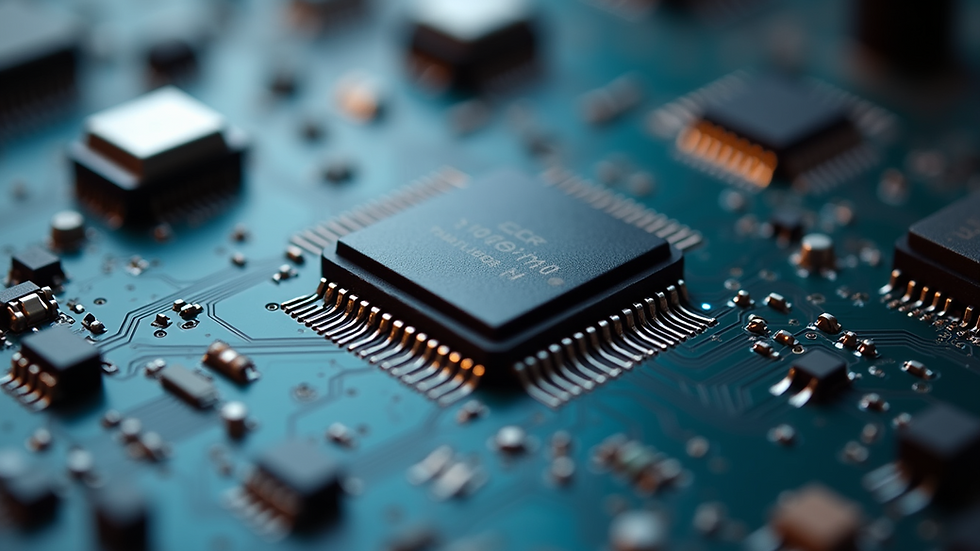CMOS and TTL Logic Circuits: Understanding Transistor Differences and Applications
- Claude Paugh

- Aug 22
- 4 min read
In the constantly evolving area of digital electronics, logic circuits serve as the backbone of countless devices. Among the most notable types are CMOS (Complementary Metal-Oxide-Semiconductor) and TTL (Transistor-Transistor Logic) circuits. By grasping the differences between these two technologies, engineers, designers, and hobbyists can make informed decisions. This article will explore the features, benefits, and specific applications of both CMOS and TTL logic circuits, offering valuable insights for anyone interested in the electronics field.

What are CMOS Logic Circuits?
CMOS logic circuits use complementary pairs of p-type and n-type MOSFETs (Metal-Oxide-Semiconductor Field-Effect Transistors) to perform a variety of logic functions. One of the standout features of CMOS technology is its minimal power consumption in a static state, which makes it particularly energy-efficient for battery-operated devices. For instance, devices like smartphones and wearables rely on CMOS technology to preserve battery life.
CMOS circuits are known for:
High noise immunity: They can tolerate interference without compromising functionality.
Wider operating voltage range: Operating voltages can be as low as 1.8V, contrasting with traditional TTL circuits that typically run at 5V.
The fundamental building blocks of CMOS logic include inverters, NAND gates, and NOR gates. Combining these components allows for the design of complex digital systems, such as processors found in modern computers and automotive electronics.
Advantages of CMOS Logic Circuits
The low power consumption of CMOS circuits stands out as a significant benefit. They only draw substantial current while switching states, making them an excellent fit for mobile and portable electronic devices. In fact, CMOS technology contributes to energy savings, potentially extending battery life by over 30% compared to other technologies.
Another notable advantage of CMOS is its scalability. As manufacturing techniques have advanced, the size of transistors has shrunk dramatically. For example, modern CMOS technologies can integrate billions of transistors on a single chip, allowing for the production of highly sophisticated microprocessors and complex integrated circuits.
In practice, CMOS circuits are found in applications ranging from consumer electronics, like digital cameras and laptops, to industrial automation systems where reliability and efficiency are crucial.
What are TTL Logic Circuits?
TTL logic circuits are constructed using bipolar junction transistors (BJTs). This design philosophy reflects in their name, "transistor-transistor logic," indicating that both the logic gates and flip-flops are based on transistors. TTL circuits are renowned for their speed and reliability, making them a common choice in various digital settings.
Operating at a standard voltage of 5V, TTL circuits generally consume more power compared to CMOS, especially in a static state. However, they can switch states faster than many CMOS circuits, making them attractive for applications that prioritize speed, such as high-speed data processing in computers.
The core components of TTL logic circuits include NAND, NOR, and NOT gates, much like CMOS. Yet, the underlying technology significantly influences their performance and robustness.
Advantages of TTL Logic Circuits
Speed is one of TTL technology's key benefits, especially for situations that demand rapid logic operations. For example, TTL circuits can switch in less than 10 nanoseconds, making them ideal for high-performance computing and communication systems.
TTL circuits also feature a simpler architecture, making them easier for newcomers to work with during prototyping and education. This accessibility has made TTL circuits a favorite in classrooms for teaching fundamental concepts in electronics.
Despite their strengths, it's worth noting that the power consumption of TTL circuits is higher, particularly during static states. This can pose challenges in battery-powered applications, where efficiency is vital.
Key Differences Between CMOS and TTL Logic Circuits
Power Consumption
CMOS circuits are celebrated for their low static power consumption. In contrast, TTL circuits draw more power even when idle. This trait makes CMOS a favorable choice for portable and energy-sensitive devices, where power conservation is essential.
Speed
When it comes to switching speeds, TTL circuits generally outpace CMOS circuits. TTL's agility is particularly advantageous for applications that require rapid signal processing.
Voltage Levels
CMOS technology can function at lower voltage levels, sometimes starting as low as 1.8V, while TTL circuits primarily operate at a firm 5V. This difference is crucial when designing circuits to ensure compatibility and optimal performance.
Noise Immunity
CMOS circuits possess superior noise immunity, enabling them to maintain consistent performance in environments with electrical interference. Although TTL circuits are not ineffective, they may show more susceptibility to noise in high-interference settings.
Integration Density
CMOS technology allows for a higher density of transistors on a single chip. This characteristic enables the development of complex integrated circuits that are smaller and more powerful than those possible with TTL.
Applications of CMOS and TTL Logic Circuits
CMOS technology is widely implemented in a variety of contemporary electronics. For instance, it's integral to microprocessors, memory chips, and digital signal processors used in smartphones, tablets, and automotive systems. The ability to achieve high integration density while consuming minimal power makes CMOS ideal for such applications.
On the other hand, TTL technology, while less common in new designs, continues to be utilized in various legacy systems and educational contexts. Its speed and reliability make TTL suitable for high-performance computing and communication systems, as well as prototyping environments.
Final Thoughts
Both CMOS and TTL logic circuits offer unique strengths and cater to different needs in the electronics landscape. CMOS technology is recognized for its low power consumption and high integration density, which makes it a preferred choice for modern electronic devices. Conversely, TTL technology excels in speed and simplicity, making it relevant for specific applications and educational endeavors.
Understanding the differences and applications of these two types of logic circuits is essential for anyone involved in electronics design and development. As technology evolves, the choice between CMOS and TTL will depend on specific application requirements, including power consumption, speed, and complexity.
